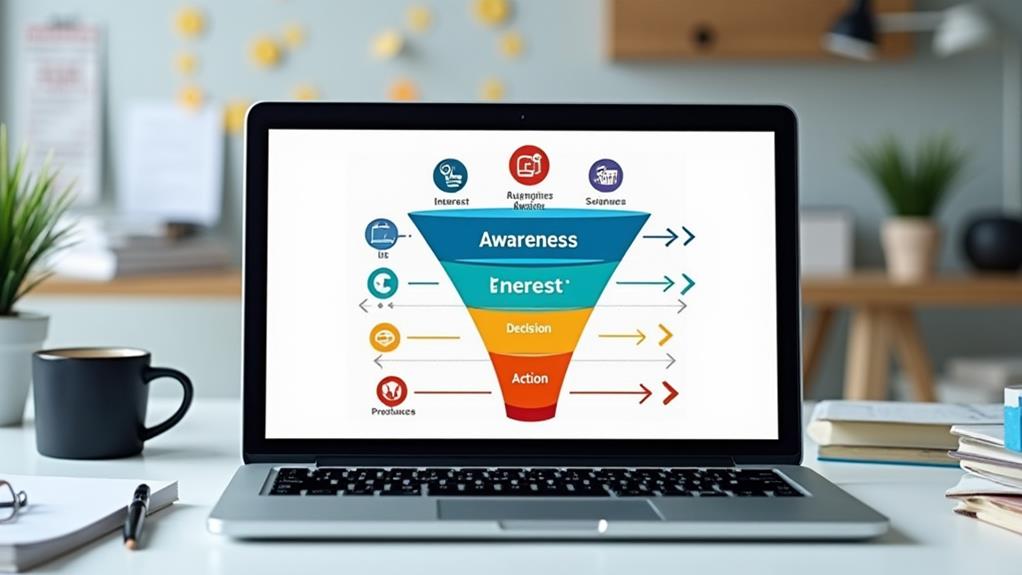
Creating a sales funnel for your online course involves several key steps. Start by defining your target audience through thorough market research and buyer personas. Craft compelling content that addresses their pain points. Utilize both paid ads with retargeting and organic content for increased visibility. Build trust through testimonials and authority-building partnerships. Optimize your funnel with clear calls-to-action and regular A/B testing to enhance conversion rates. Post-enrollment, engage students with tailored onboarding and community-building efforts to boost retention. Effective implementation of these strategies will guide potential students from awareness to enrollment seamlessly. Discover more insights to refine your sales funnel approach.
Key Takeaways
- Conduct thorough market research to define your target audience and segment them effectively.
- Create high-quality, engaging content tailored to each funnel stage, using visual storytelling and video marketing.
- Utilize paid advertising and organic content strategies to attract and engage leads.
- Develop compelling lead magnets, like free video courses and webinars, to capture emails and nurture leads.
- Optimize conversion processes with clear CTAs, streamlined checkouts, and strategic launch sequences.
Understanding the Sales Funnel
Understanding the sales funnel is vital for effectively marketing online courses, as it represents a structured series of steps designed to guide potential customers from initial awareness to the point of purchase. The funnel metrics provide invaluable insights into the user journey, helping to optimize each stage: Awareness, Interest, Desire, and Action.
In the Awareness stage, attention is captured through tactics like paid ads, blog posts, and social media engagement. This stage is essential for generating leads and is typically the easiest entry point into the funnel.
Tracking funnel metrics such as click-through rates and engagement levels can help in refining these strategies. Analyzing competitor offerings can also help in identifying unique positioning and tailoring your services to meet the needs of your target audience.
During the Interest stage, leads are nurtured with valuable content addressing their pain points, often through educational materials and interactive engagement.
Metrics such as time spent on page and content interaction rates are critical for evaluating the effectiveness of this nurturing process.
The Desire stage focuses on deepening emotional connections by showcasing the course's benefits and solutions, preparing leads for conversion.
Monitoring conversion rates and user feedback at this stage helps in fine-tuning the messaging.
Defining Your Target Audience
To effectively define your target audience, start by conducting thorough market research to identify ideal students through buyer personas that highlight demographics, interests, and pain points using tools like Google Analytics and surveys.
Personalized learning paths revolutionize student interaction with knowledge, catering to unique needs through individualized assessments that identify specific strengths and weaknesses.
Pinpointing where your audience is most active online, such as Facebook Groups or YouTube, will streamline your marketing efforts and guarantee engagement on preferred platforms.
Additionally, leveraging direct feedback and monitoring social media discussions can help tailor your course content to address specific needs, thereby enhancing its appeal and conversion potential.
Identifying Ideal Students
Crafting a highly effective sales funnel for online courses begins with pinpointing your ideal students through detailed buyer personas. By focusing on student demographics and audience segmentation, you can create precise marketing strategies that resonate with your target audience.
Start by analyzing data on age, gender, location, and educational background to build a thorough profile of your potential students.
Researching where your ideal students congregate online is essential. Utilize tools like Google Analytics and social media insights to understand their behavior and preferences. This data informs your marketing strategy, ensuring your content appears where your audience is most active.
Engage with potential students through surveys, interviews, and monitoring online forums. This direct interaction provides valuable insights into their interests and pain points, allowing you to tailor your course content and marketing messages accordingly.
Consider the following steps to identify your ideal students:
- Utilize Google Analytics: Analyze demographic data and user behavior.
- Social Media Insights: Leverage platform-specific analytics to understand engagement.
- Conduct Surveys and Interviews: Gather direct feedback on needs and challenges.
- Monitor Online Communities: Observe discussions in forums relevant to your course.
- Address Specific Pain Points: Create content that directly resolves identified issues.
Understanding Audience Needs
Pinpointing your target audience's needs is fundamental for the success of an online course sales funnel. Conducting in-depth market research is the first step, leveraging tools like Google Analytics and surveys to gather demographic insights for effective audience segmentation.
Develop ideal buyer personas to clearly define who your course is for, guaranteeing that your marketing efforts are precisely directed.
Identifying specific pain points and needs is essential. Methods such as monitoring social media discussions, analyzing Amazon reviews, and engaging in Quora questions can reveal valuable insights.
This feedback analysis helps in understanding the challenges and expectations of your audience, allowing you to tailor your course content to meet their needs effectively.
Utilize feedback from potential customers to refine your course offering. Confirm that your content aligns with their expectations and addresses their unique challenges.
Leverage educational content and lead magnets, like free courses or downloadable resources, to provide immediate value and attract your audience.
Regularly updating your understanding of audience preferences and trends is critical. With 68% of companies lacking a sales funnel, there is a significant opportunity for effective audience engagement.
Staying relevant and responsive to your audience's evolving needs will enhance your sales funnel's efficacy.
Crafting Compelling Content
Developing high-quality content that captivates and converts is essential for each stage of the sales funnel. Crafting compelling content requires a strategic approach incorporating various content formats to maximize audience engagement.
Visual storytelling and video marketing are pivotal, with 72% of individuals preferring video over text, making it a powerful tool for engagement and learning. Employ storytelling techniques to build an emotional connection with your audience, illustrating relatable experiences that address their pain points. Leveraging behavioral insights can also refine your content strategy, guaranteeing messages resonate effectively with your audience.
Lead magnets, such as free courses or downloadable guides, must be tailored to specific audience needs, as 79% of marketing leads do not convert without nurturing. High-quality blog posts and articles can enhance authority and trust, with long-form content (1,500+ words) typically ranking better in search engines and offering in-depth value.
To maintain interest and drive conversions, consider the following strategies:
- Interactive content: Quizzes, surveys, and polls to boost audience engagement.
- Content repurposing: Transform blogs into videos, infographics, or podcasts.
- User-generated content: Encourage testimonials and reviews for social proof.
- Content personalization: Tailor messages to individual preferences for relevance.
- Regular updates: Refresh content based on audience feedback and market trends.
Implementing these tactics will guarantee your content remains compelling and effective throughout the sales funnel.
Awareness Stage Strategies
In the awareness stage, leveraging paid advertising on platforms like Facebook and Google can provide immediate visibility and measurable results, quickly attracting new leads.
Complement this with organic content such as engaging blog posts that address specific pain points to establish authority and drive targeted traffic.
Additionally, forming strategic partnerships with influencers and utilizing social media platforms like Facebook Groups and YouTube can amplify reach and foster community engagement.
Monitor trends to stay relevant and use social media analytics for insights to continually refine your strategies.
Leverage Paid Advertising
Harnessing the power of paid advertising, platforms like Facebook and Google Ads provide immediate visibility and targeted reach, making them invaluable tools for the awareness stage of your sales funnel for online courses.
Implementing precise ad targeting strategies allows you to reach specific demographics and interests, driving traffic to your course's landing page efficiently. With advertisers earning an average of $2 for every $1 spent on Facebook ads, the ROI potential is substantial.
Optimizing your ad creative is vital. A/B testing, or campaign testing approaches, can help you identify the most engaging messages and visuals, enhancing ad performance metrics.
Retargeting techniques are also important; by re-engaging users who have previously visited your site, you increase the likelihood of conversion. Additionally, incorporating strong call-to-action effectiveness in your ads can boost click-through rates by up to 121%.
To guarantee maximum efficiency, consider these key elements:
- Audience segmentation methods: Tailor your ads to specific user groups for better engagement.
- Budget allocation tips: Strategically distribute your advertising budget to maximize ROI.
- Ad creative optimization: Continuously refine your visuals and messages.
- Ad performance metrics: Regularly monitor and adjust based on performance data.
- Retargeting techniques: Re-engage past visitors to encourage conversions.
Produce Organic Content
Creating organic content is a powerful way to drive awareness and build credibility for your online courses. High-quality blog posts are instrumental, as 60% of marketers prioritize blogging strategies for lead generation. By addressing your target audience's pain points, you can considerably increase organic traffic.
Implementing SEO strategies, such as targeting long-tail keywords, can further enhance your search engine rankings, driving more relevant traffic to your course website.
Content marketing through educational videos is another effective approach. With 72% of individuals preferring video content for learning, platforms like YouTube can enhance engagement and establish your authority in your niche.
Complementing your blog posts and videos with free downloadable resources, such as checklists or guides, can serve as enticing lead magnets. These resources encourage visitors to provide their email addresses, facilitating future marketing efforts.
Additionally, engaging in social media platforms like Facebook Groups and Reddit communities relevant to your course topic can help foster connections and expand your audience organically.
Form Strategic Partnerships
Forming strategic partnerships with influencers or organizations within your niche can be a game-changer for increasing visibility and driving engagement. By leveraging influencer collaborations and targeted partnership strategies, you can tap into new audiences and build credibility.
This approach not only amplifies your marketing efforts but also provides essential touchpoints for audience engagement, a critical factor given that 79% of marketing leads do not convert without effective follow-up.
Strategic Partnership Benefits:
- Influencer Collaborations: Partnering with influencers can enhance your reach and credibility, as their endorsement serves as a powerful testimonial.
- Joint Promotions: Co-hosted events such as webinars or workshops can attract new leads, providing real-time interaction that boosts engagement and conversion rates.
- Content Exchange: Guest blogging or podcast appearances allow you to tap into established audiences, offering mutual benefits through shared content and insights.
- Networking Opportunities: Partnering with other course creators or businesses opens doors for networking, creating opportunities for future collaborations.
- Shared Resources: Utilizing social media groups and forums to share valuable content positions you as an authority, increasing awareness and interest among potential students.
Incorporating these partnership strategies into your sales funnel will not only enhance visibility but also foster a robust network, ultimately driving higher conversion rates.
Leveraging Paid Ads

Leveraging paid ads on platforms such as Facebook and Google can greatly amplify the visibility of your online courses, providing a swift and effective means to reach a targeted audience and generate leads.
According to a study by WordStream, businesses generate an average of $2 in revenue for every $1 spent on Google Ads, indicating a considerable potential for a robust return on investment when executed properly. When considering ad spend, it's essential to evaluate commission rates and ascertain that your investment aligns with your financial goals.
One of the most effective techniques within paid advertising is the use of retargeting strategies. Research shows that retargeted ads can achieve click-through rates up to 10 times higher than standard display ads, thereby greatly enhancing conversion rates.
By targeting users who have previously interacted with your content, you can maintain a consistent brand presence and guide them further down the sales funnel.
Additionally, A/B testing various ad creatives and copy is vital for optimizing campaign performance. By experimenting with different visuals and messages, you can identify what resonates best with your audience, guaranteeing that your ad spend is used efficiently.
Lastly, the success of paid ads heavily relies on a seamless shift to a well-structured landing page that clearly communicates your course benefits, maximizing the likelihood of conversion.
Effective Lead Magnets
Effective lead magnets, such as free video courses and downloadable checklists, can boost email sign-up rates by up to 30% by providing valuable resources that attract and engage potential customers.
With 72% of individuals favoring video content for learning, offering video-based lead magnets greatly enhances engagement and conversion rates.
Crafting valuable offers that establish trust and authority is essential, as 79% of marketing leads fail to convert without effective lead nurturing, making gated content and regular optimization vital strategies.
Selecting the right lead magnets that align with your niche can also improve audience retention and foster long-term customer relationships.
Types of Lead Magnets
When designing a successful sales funnel for online courses, understanding the types of lead magnets that effectively attract and engage potential customers is essential.
Leveraging the right lead magnets can greatly enhance your conversion rates and build a robust email list. Here are some data-driven, conversion-oriented options:
- Video Courses: Preferred by 72% of learners, free video courses not only provide value but also help capture email addresses and nurture leads.
- Downloadable Resources: PDFs, checklists, and templates offer immediate value. With 63% of marketers finding gated content effective, these resources are a proven strategy for lead generation.
- Exclusive Discounts: Limited-time offers and trials can entice potential customers. Studies show that 50% of consumers are more likely to sign up when presented with exclusive discounts.
- Educational Webinars: As 73% of marketers state that webinars generate quality leads and build niche authority, they are a compelling lead magnet.
- Case Studies and Success Stories: Showcasing real-life results can enhance trust and engagement. With 79% of consumers influenced by user-generated content, these narratives can greatly impact purchasing decisions.
Incorporating these lead magnets into your sales funnel can optimize engagement and conversion, paving the way for successful online course sales.
Crafting Valuable Offers
Understanding the types of lead magnets is only the first step; the next critical phase is crafting valuable offers that resonate with your audience and drive conversions. Effective lead magnets, such as free video courses, can greatly increase email sign-ups, as 72% of individuals prefer learning through video content over text. This highlights the importance of aligning your value proposition with audience preferences.
To enhance offer positioning, consider providing resources like checklists, PDFs, or free trials. These not only attract potential leads but also help establish trust and authority in your niche. Remember, lead magnets should directly address your target audience's pain points; 79% of marketing leads never convert to paying customers, often due to a lack of relevant engagement.
Gated content, which restricts access until a user provides their email, can effectively capture leads while offering immediate value in exchange for contact information.
Regularly updating and testing different lead magnets can optimize conversion rates. Ongoing analysis allows for the identification of what resonates most with your audience, ensuring your offers remain compelling.
Email Funnel Importance

Harnessing the power of email funnels can greatly transform your online course sales strategy, making it an indispensable tool for digital product promotion.
Email funnels capitalize on high engagement rates, offering an ROI of up to 4,400%. By implementing effective email segmentation strategies and automated follow ups, businesses can nurture leads through targeted email sequences, guiding potential customers from initial interest to purchase and markedly boosting conversion rates.
In fact, integrating personalization techniques can increase open rates by 26%, and behavioral targeting can make offers more relevant and engaging.
Key benefits of integrating an email funnel into your online course sales strategy include:
- High Engagement: Welcome emails have an impressive open rate of 50%, establishing a positive first impression and fostering ongoing engagement.
- Personalization: Leveraging email segmentation strategies allows for the delivery of tailored content, increasing relevance and engagement.
- Automation: Automated follow ups guarantee timely delivery of valuable content, exclusive offers, and reminders, enhancing conversion likelihood.
- Preference: With 72% of individuals favoring email for learning, regularly sending educational and promotional content keeps your course top-of-mind.
- ROI: Email marketing can yield an extraordinary ROI, making it a cost-effective method for promoting your online course.
Building Trust and Authority
Building trust and authority is a foundational element in converting prospects into loyal students for your online courses. Establishing this trust can be effectively achieved through storytelling techniques that resonate with your audience's challenges and goals. Sharing personal stories and experiences enhances relatability, creating a connection that underpins authenticity—because authenticity matters greatly in building credibility.
Additionally, using interactive features like quizzes or polls can further engage your audience, making them feel involved and valued.
To further demonstrate your expertise, provide valuable content such as educational blog posts, video tutorials, and testimonials. These resources not only showcase your knowledge but also address your audience's pain points directly. By illustrating how your course offers solutions to these challenges, you create a sense of urgency and position yourself as a trusted resource.
Engaging with your audience through interactive elements, such as Q&A sessions and feedback requests, fosters a community atmosphere. This engagement reinforces your authority and invites ongoing dialogue, making your audience feel heard and valued.
Additionally, consistent communication and transparency about your vision, mission, and core values solidify trust. When potential students see a clear alignment between your values and their needs, they are more likely to believe in and commit to your offerings, thereby driving conversions.
Converting Interest to Action

Driving conversions from interested prospects to active students involves a strategic approach that emphasizes clarity, transparency, and engagement.
To effectively convert interest into action, it is vital to outline the course components, pricing structure, and enrollment process clearly. This transparency builds trust and reduces any friction that may deter potential buyers. Additionally, offering specialized training programs can enhance your credibility and attract more students by showcasing your expertise in the subject matter.
Addressing common objections and fears through course testimonials and social proof is a powerful sales psychology technique. Sharing success stories and providing clear answers can alleviate concerns and encourage purchasing decisions.
Additionally, implementing a well-thought-out launch sequence can connect the audience's prior interest to the next steps, nurturing their desire to enroll.
Presenting clear next steps is essential to guide potential buyers seamlessly. Simplified instructions on how to purchase and access the course guarantee the process is straightforward.
Automated email follow-ups targeting individuals who show interest but haven't purchased immediately can provide additional valuable content, helping to nurture their interest further.
- Clearly outline course components, pricing, and enrollment process
- Use course testimonials and social proof to address objections
- Implement a strategic launch sequence to nurture interest
- Provide clear, simplified next steps for purchasing
- Utilize automated email follow-ups for nurturing leads
Optimizing for Conversions
To maximize the effectiveness of your sales funnel, optimizing for conversions is vital. Clear calls-to-action (CTAs) are pivotal, as they can increase conversion rates by up to 200%. Make sure your CTAs are strategically placed and compelling to guide potential customers toward making a purchase decision.
Implement A/B testing on your landing pages to determine which elements resonate most with your audience. Through testing variations of headlines, images, and CTAs, you can improve conversion rates by 20-30%.
Additionally, utilizing lead magnet strategies is important. Offering free resources or discounts to capture email addresses can boost conversion rates by 50% or more.
Interactive tools like quizzes can also enhance engagement and provide valuable insights into customer preferences, helping you tailor your offerings more effectively.
Checkout optimization is another essential component. Streamline the process by minimizing the number of steps required to complete a purchase. Simplifying checkout can reduce cart abandonment rates by up to 70%.
Lastly, continuously analyze and refine your funnel's performance through funnel analytics. Monitoring key metrics such as conversion rates and customer acquisition costs allows you to identify areas for improvement.
Post-Enrollment Engagement

Effective post-enrollment engagement is essential for boosting course completion rates, with studies indicating that engaged learners are 70% more likely to finish their courses.
Implementing robust engagement strategies not only enhances course satisfaction but also greatly improves learner involvement and retention.
To optimize post-enrollment engagement, consider the following data-driven approaches:
- Onboarding Processes: Send personalized welcome emails with clear course access instructions and additional resources to guarantee a smooth start and high initial satisfaction.
- Motivational Reminders: Utilize automated emails or course updates to provide regular check-ins, keeping learners motivated and reminding them of upcoming lessons or assignments.
- Community Building: Create forums, social media groups, or host live Q&A sessions to foster a sense of belonging and encourage peer interaction, which can increase retention rates by up to 30%.
- Feedback Mechanisms: Collect regular feedback from students to identify areas for improvement. Adapting content based on this feedback can enhance the overall learning experience.
- Retention Techniques: Implement strategies like gamification, progress tracking, and reward systems to keep learners actively engaged and motivated throughout the course.
Frequently Asked Questions
How to Build a Funnel for an Online Course?
To build a funnel for an online course, define funnel stages (Awareness, Interest, Desire, Action), drive traffic sources through lead magnets, optimize landing pages for conversions, conduct A/B testing, and analyze key metrics for continuous improvement.
How Do You Create a Sales Funnel for Beginners?
Creating a sales funnel for beginners involves identifying your target audience, utilizing lead magnets, crafting engaging email sequences, designing optimized landing pages, analyzing conversion rates, and leveraging effective marketing strategies, content marketing, and social media to drive conversions.
How Do I Create an Online Course Sales Page?
To create an effective online course sales page, focus on clear headlines, engaging visuals of course content, and persuasive copy addressing the target audience's pain points. Use testimonials for social proof and guarantee a prominent, mobile-optimized CTA.
Can I Create an Online Course With Clickfunnels?
Yes, you can create an online course with ClickFunnels. Utilizing ClickFunnels features like customizable templates and integrated payment processing, alongside funnel optimization and automated email marketing, guarantees a seamless, conversion-oriented process from awareness to enrollment.
Conclusion
In conclusion, constructing an effective sales funnel for an online course necessitates a thorough understanding of the sales funnel stages, precise audience targeting, and the creation of compelling content. Implementing awareness strategies, leveraging paid advertisements, and establishing trust and authority are essential for converting interest into action. Continuous optimization for conversions and sustained post-enrollment engagement further guarantee the success and profitability of the course. Employing these strategies can greatly enhance the overall conversion rate and return on investment.
Leave a Reply